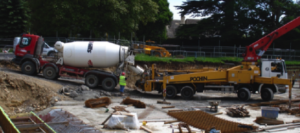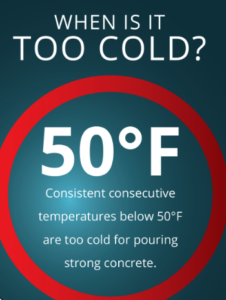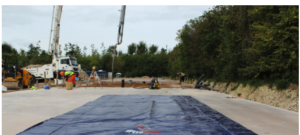American Made, Iron Clad Protected - Discover the Industries Best Warranty.
Blog
How to Use Concrete Blankets
 Pouring concrete presents a plethora of difficult challenges, and when cold weather comes into the mix, things get even more complicated. This is because concrete needs to dry and develop properly in order to maintain safe levels of strength and integrity, which means it needs to be protected from freezing shortly after pouring. But pouring concrete in cold weather is entirely possible, and Steel Guard Safety’s concrete blankets can help.
Pouring concrete presents a plethora of difficult challenges, and when cold weather comes into the mix, things get even more complicated. This is because concrete needs to dry and develop properly in order to maintain safe levels of strength and integrity, which means it needs to be protected from freezing shortly after pouring. But pouring concrete in cold weather is entirely possible, and Steel Guard Safety’s concrete blankets can help.
TIPS FOR POURING CONCRETE IN COLD WEATHER
 According to the American Concrete Institute, concrete is exposed to cold weather conditions whenever the average daily temperature is below 5ºC (40ºF) and the air temperature doesn’t rise above 10ºC (50ºF) for more than half of any 24-hour period. In these conditions, the concrete may be in danger of freezing and the cold weather can interfere with the setting and curing process. If local weather trends indicate you might be facing these conditions as you pour or manage the concrete, you should plan to take precautions against cold weather.
According to the American Concrete Institute, concrete is exposed to cold weather conditions whenever the average daily temperature is below 5ºC (40ºF) and the air temperature doesn’t rise above 10ºC (50ºF) for more than half of any 24-hour period. In these conditions, the concrete may be in danger of freezing and the cold weather can interfere with the setting and curing process. If local weather trends indicate you might be facing these conditions as you pour or manage the concrete, you should plan to take precautions against cold weather.
There are a variety of methods available to keep concrete at a sufficient temperature, but concrete blankets are one of the simplest and most effective. These insulated thermal tarps can be used as concrete curing blankets, temporary curtain walls, or temporary heat enclosure, making them a versatile tool for creating the proper temperature environment for curing concrete. No matter how they’re used, it’s critical to diligently measure and record the temperature of the concrete to ensure it never dips below the required target.
As always, it’s important to consider the specific challenges of the job at hand when planning to pour concrete in cold weather. If there are specific strength requirements for the concrete, make sure you’re keeping the concrete at temperatures that will allow it to meet those requirements. Also remember to never pour concrete on ice, snow, or frozen ground – if the ground freezes, you’ll need to heat and thaw it before pouring the concrete.
STEPS TO POUR CONCRETE IN COLD WEATHER
- Pour Concrete ONLY on Non-Frozen Earth.
- Be sure to order air-entrained concrete.
- Keep a Heated Mix or Alternatively order 100 lbs of Extra Cement for every Cubic Yard Keeping More Strength Early in the Curing Process.
- Order a Low Sump Mix to Stop Water Bleed.
- After Lay and Finish is Completed, and Bleed Water has Evaporated, Cover the Concrete with Insulated Curing Blankets to Stabilize at the Constant Optimal Temperature.
- After about 72 Hours, Remove the Thermal Concrete Blankets and Allow the Slats to Air Dry.
ORDER CONCRETE CURING BLANKETS ONLINE
Concrete curing blankets are a vital part of successfully and safely pouring concrete in cold weather conditions, and at Steel Guard Safety, we’re proud to offer dependable, high-quality concrete blankets at excellent prices. Don’t take chances when it comes to the safety and stability of the job: request a quote online to see how our concrete blankets can make your workplace, and our world, a safer place.
REFERENCES
American Concrete Institute – Curing in Cold Weather
Recent Posts
- Noisiest Cities in the US
- Warehouse Cooling – 10 Ways to Upgrade Without AC
- How to Prepare your Construction Site for Winter – 7 Useful Products
- Clear Vinyl Tarps: Where are the Useful Tarps Used
- How to Design an Acoustic Enclosure in the Workspace
- Welding blanket guide: How to choose the right welding blanket
- Industrial Curtains: How These Curtains Will Save Space in the Covid Era
- How clear vinyl tarps extend outdoor dining for restaurants
- How to Safely Open Up Your Restaurant
- Personal partitions and dividers – where and how they are being used
Categories
- Accordion Fold Curtains
- Agri-Shield Curtains
- Auto Body Shop Curtains
- Bio Plastics
- Industrial Divider Curtains
- Industrial Safety Products
- Insulated Curtain Walls
- Machine Guard Safety Fencing
- Mesh Curtain Screens
- PVC Strip Curtains
- Soundproof Noise Blocking Curtains
- Spray Paint Booth Curtains
- Tarps
- Thermal Curtains & Covers
- Uncategorized
- Warehouse Dividers
- Welding Blankets
- Welding Curtains
- Welding Screens



